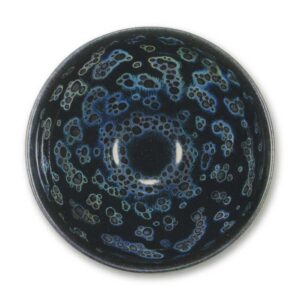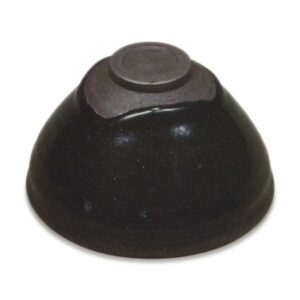

I. Name: Inaba Tenmoku
one of the great treasures of Japan
National Treasure
Collection: Seikado
Height: 6.8cm
Mouth diameter: 12.0cm
Outer diameter of stand: 3.8cm
Height: 0.5cm
This is a famous bowl, generally known as “Inaba-temmoku”, which is the king of yohen and tenmoku.
The shape of this bowl is correct “kenzan” and has a tight feeling. The inside of the base has been cut shallowly and flatly to make a serpentine shape, but there is not the slightest distortion, which clearly shows that this is a special masterpiece. The base is relatively fine-grained and hard-fired, with a dark grayish-red color and a dull luster.
The inside and outside of the bowl is covered with a lot of shiny black glaze, the glaze around the mouth rim is grayish, and there are thick glaze puddles at the edge of the bowl and at the bottom. The glazed surface is covered with irregularly scattered round spots called “hoshimon” (star patterns) of various sizes, and the glistening glare around them flickers like a dream and makes the glossy black glazed surface gorgeous. This is the so-called “yohen” phenomenon, and it is well in line with the description in the “Kimidai Kanjo Joki” that “there are stars of deep lapis lazuli and light lapis lazuli in the sky. The star patterns floating in a bluish-white circle of a certain width around the prospective viewpoint are particularly exquisite. The outer surface is generally jet black, but there are a few blue spots.
Kazuo Yamazaki has made a detailed study of this phenomenon of yohening. According to this research, it is assumed to be caused by a group of fine crystals and a very thin film of only 1/10,000th of a millimeter formed on the glaze, but the composition of these crystals is not yet known at all.
This tea bowl was handed down from the Genna and Kan’ei periods to the Inaba family of Yodo, who held important positions in the shogunate for generations, hence the name Inaba Tenmoku. It is this very bowl that is listed as “Yohen Inaba Minoden” in “Gankan Meibutsuki” and “Yohen Inaba Minomori” in “Kokin Meibutsu Ruiju”. There are no clues as to its earlier origin, but it is said that the Inaba family may have received it from the Yanagiei Gomotsu.
After the Meiji Restoration, it remained in the Inaba family’s possession until 1918, when it left the Inaba family and came into the possession of Mr. Tetsuro Ono. The bidding for the piece brought a record high price of 168,000 yen at the time, and the story has long been told. Later, it was transferred to the Iwasaki family, and from the Iwasaki family to the Seikado Bunko, where it has remained to this day.
Bag, large arabesque patterned satin on white ground
Gold-ground double vine gold-ribbon
Inner box, Shunkei lacquer pasted paper, “Yohhen
Outer box, black lacquer, blue shell script “Yohhen
Tenmoku-dai, black Urushi nunzakidai, Mayu cover ring
Designated as a New National Treasure in June 1951.



